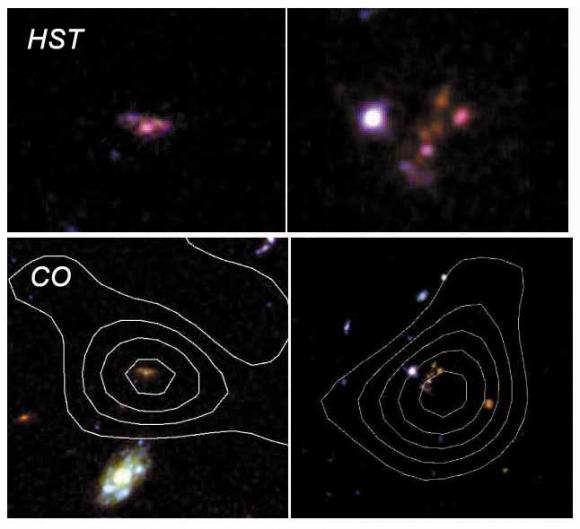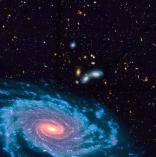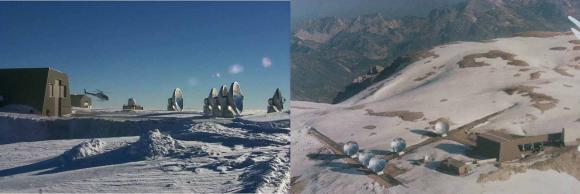An international team of astronomers lead by scientists of the Astrophysics Division of CEA-IRFU has discovered large molecular gas reservoirs - the combustible for forming new stars - hosted in ordinary massive galaxies in the young, distant Universe. The discovery has been made with the IRAM Plateau de Bure Interferometer located in the French Alps, observing at millimeter wavelengths. This finding indicates that massive galaxies built major fractions of their stars in a nearly continuous way, and not on very rapid bursts as thought before, and open new major possibilities for understanding galaxy formation at high redshifts. The results are published in the January 2008 issue of the Astrophysical Journal.
Image credits: MPIA Heidelberg (Hi_res 1.7Mo / Med_res 0.4Mo)
How do the stars form in the young Universe ?
Star formation in the local universe is observed to take place in two fundamental modes.
In spiral galaxies - like our Milky Way - new stars are formed primarily in the spiral arms of the disk-like structure. These are the sites which contain most of the combustible for star formation - molecular hydrogen gas. Currently, one solar mass per year is produced in our Milky Way and the activity is thought to last for billions of years.
When spiral galaxies merge, a more efficient process is observed in which stars are formed at much higher rates. During major galaxy collisions, the molecular gas is efficiently compressed toward the center of the merging system, reaching densities that are much higher than in spiral galaxies. This can enhance the rate of star formation up to several hundred solar masses per year, or more, in these objects, which are thought to very rapidly consume their fuel. Astronomers call the resulting galaxies Ultra-Luminous InfraRed Galaxies.
But what is the dominating mode of star formation in the young universe ? Collisions of galaxies in the distant Universe are thought to be much more common than nowadays, and even ordinary massive galaxies in the distant Universe were forming stars at prodigious rates.
This provided widespread support to the idea that the predominant star formation mode in the distant Universe was the collisions-like, high efficient one. Observations of molecular gas properties in distant galaxies, limited to the brightest and rarest systems, had so far confirmed this picture.
Using high sensitivity newly refurbished millimeter detectors at the Plateau de Bure Interferometer*, an international team of astronomers have been able for the first time to measure the molecular gas content of ordinary and representative galaxies in the distant Universe. The team, including Helmut Dannerbauer from the Max-Planck-Institute for Astronomy in Heidelberg (Germany), observed two massive, disk-like galaxies which emitted their light 4.3 billion years after the big bang and succeeded in detecting both sources.
Emanuele Daddi from SAP/IRFU at CEA-Saclay (France) lead the research. The findings, described in a paper that is appearing on Astrophysical Journal Letters on January 20th 2008, have profound consequences for understanding the processes regulating massive galaxy formation in the distant Universe. Both galaxies are found to host giant gas reservoirs, but with a star formation mode that closely resembles the one observed in local spiral galaxies, a phenomenon observed here for the first time. The ordinary distant massive galaxies behave like scaled-up version of the Milky Way galaxy, with proportionally larger molecular gas reservoir and star formation activity, but with overall similar efficiency in forming stars.

Top : Hubble Space Telescope color image of the two massive galaxies at a distance of more than 9 billions light-years. Red channels are for near-infrared light, tracing old stars and regions affected by dust. Blue channels for ultraviolet light that is due to newly formed stars. Both galaxies appear very clumpy and contains several knots.
Bottom : Contours of the molecular gas first detected in these galaxies (visible at the centre). The discovery of large gas masses surrounding the galaxies implies that most likely the clumps are the direct product of gas fragmentation into large stellar clusters.
Pictures: E.Daddi [CEA-France] / HST / NASA
This discovery is helping astronomers to shed light into the way galaxy assembled and formed their stars. It suggests that mergers between galaxies are not the major channel for the assembly of stars in distant galaxies. The large gas reservoirs newly observed could maintain star formation in these galaxies over IRAM, ten times longer than in the extreme sources that were known before, implying that a large fraction of the stars in massive galaxies is formed relatively slowly and „in situ". These observations also help to explain the clumpy-like appearence of distant galaxies, because the large gas reservoirs are prone to fragmentation due to gravitational instabilities.
These new observations have also shown that ordinary galaxies in the distant Universe, 10-100 times more common than the extreme sources so far studied, are now within reach of direct observations of their molecular gas content with current facilities as IRAM and forthcoming ones like ALMA (Atacama Large Millimeter Array), an array of 64 antennes under construction in Chile. As the gas is the primary ingredient from where stars, and therefore galaxies, are formed, this result is opening a new major research window into understanding the physical processes regulating galaxy formation.
Contacts : ,
"Vigorous Star Formation with low Efficiency in Massive Disk Galaxies at z=1.5"
Emanuele Daddi (1), Helmut Dannerbauer(2), David Elbaz(1), Mark Dickinson(3), Glenn Morrison(4,5), Daniel Stern(6) & S. Ravindranath(7)
(1) Service d'Astrophysique, CEA Saclay, Orme des Merisiers, 91191 Gif-sur-Yvette Cedex, France
(2) MPIA, Königstuhl 17, D-69117 Heidelberg, Germany
(3) NOAO, 950 N. Cherry Ave., Tucson, AZ, 85719
(4) Institute for Astronomy, University of Hawaii, Honolulu, HI 96822, USA
(5) Canada-France-Hawaii Telescope, Kamuela, HI, 96743, USA
(6) Jet Propulsion Laboratory, Caltech, Pasadena, CA 91109
(7) IUCAA, Pune University Campus, Pune 411007, Maharashtra, India
published in the Astrophysical Journal Letters 673, L21, 20 Janurary 2008
- for an electronic version : (fichier pdf - 412 Ko)
see also :
| - the Max Planck Heidelberg Press Release (23 Janvier 2008) |
for more information - No more starless galaxies ? (15 Novembre 2007)
- Débat sur la formation des étoiles(in french, 19 Octobre 2007)
- Formation d'étoiles dans l'Univers lointain (in french, 7 June 2007)




